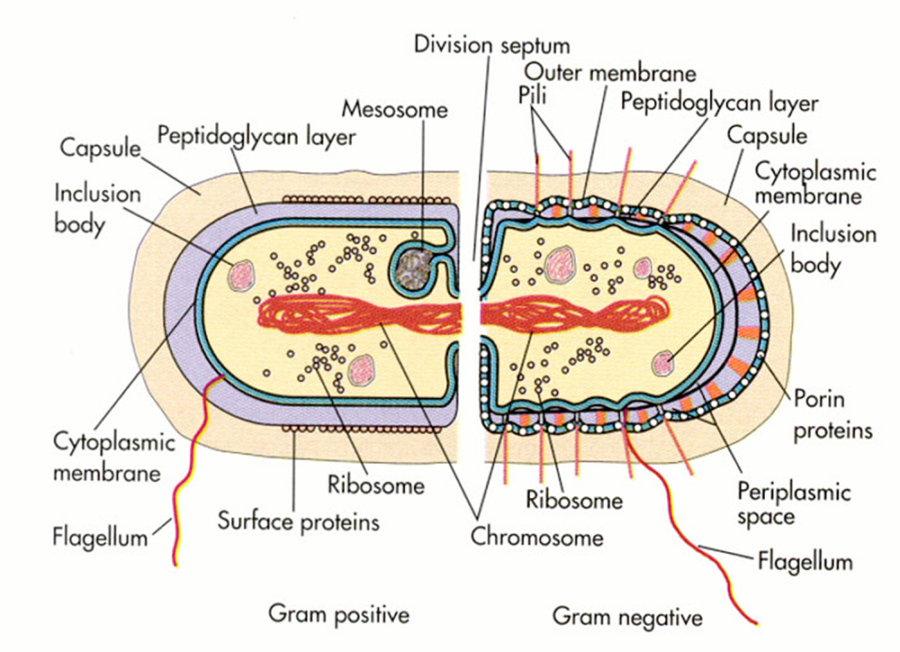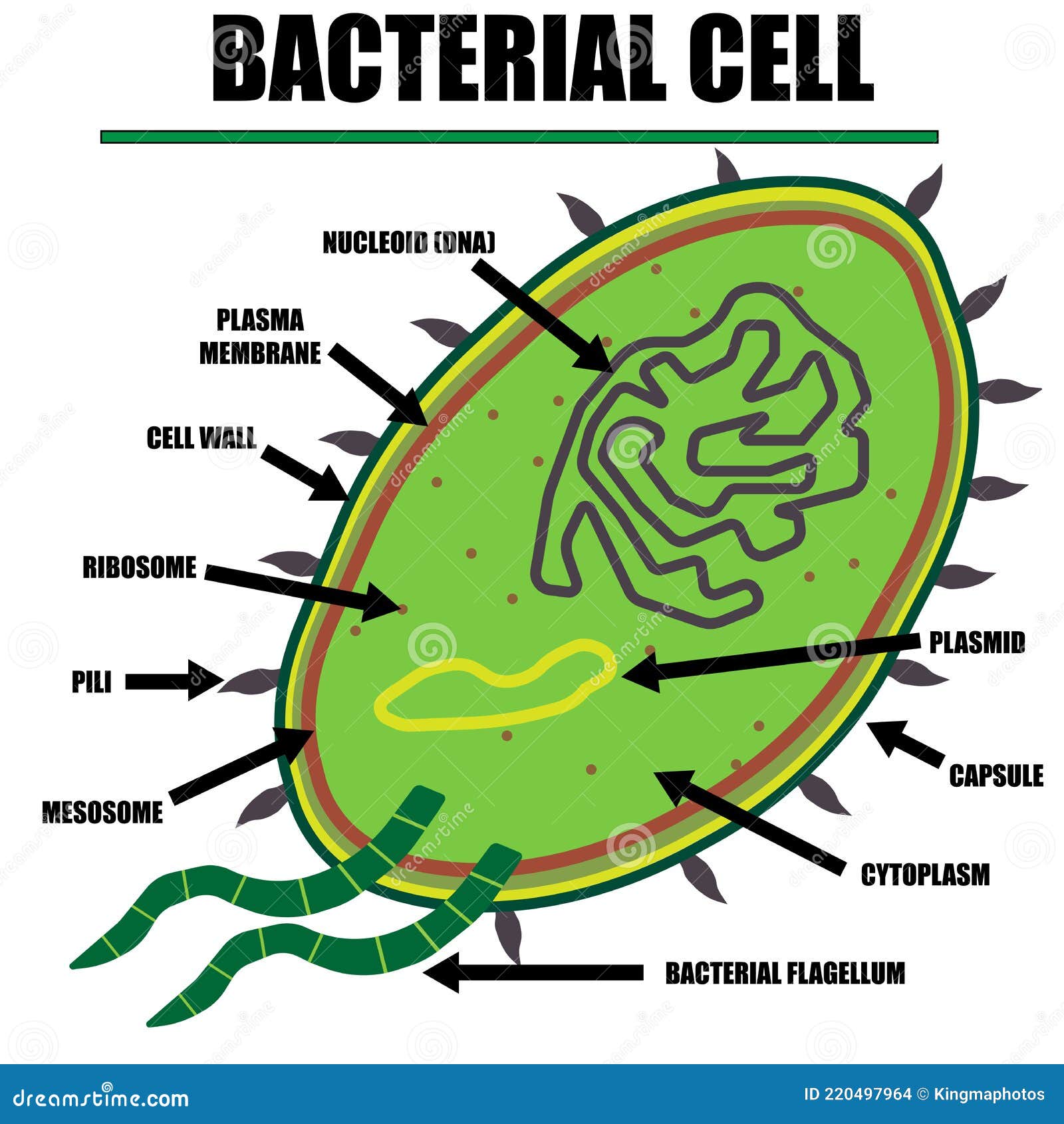
Bacteria Grade 11 Biology Study Guide
Labelled diagram of a bacterial cell: Cell Capsule: It is a slime layer composed of a thick polysaccharide. It covers the outside of the cell wall. Cell wall: Cell walls of bacteria are made up of glycoprotein murein. Its function is protection. Cell membrane:

Bacterial cell structure and function YouTube
It also means that you—for some definition of the word you—actually consist of both of the major types of cells: prokaryotic and eukaryotic. All cells fall into one of these two broad categories. Only the single-celled organisms of the domains Bacteria and Archaea are classified as prokaryotes— pro means before and kary means nucleus.

Bacteria Cell Vector Art, Icons, and Graphics for Free Download
Bacterial cells close bacterial cell A microscopic individual cell of a bacterium. have a more simple structure compared to animal, plant and fungal cells and are usually much smaller.

Bacterial cell anatomy in flat style. Vector modern illustration. Labeling structures on a
Capsule/Glycocalyx Some bacteria are surrounded by a gelatinous substance which is composed of polysaccharides or polypeptide or both. A thick layer of glycocalyx bound tightly to the cell wall is called capsule. It protects cell from desiccation and antibiotics.

Bacterial Cell Diagrams 101 Diagrams
Bacterial cell have simpler internal structure. It lacks all membrane bound cell organelles such as mitochondria, lysosome, golgi, endoplasmic reticulum, chloroplast, peroxisome, glyoxysome, and true vacuole. Bacteria also lacks true membrane bound nucleus and nucleolus. The bacterial nucleus is known as nucleoid.

prokaryotic cell bacteria parts
The bacteria shapes, structure, and labeled diagrams are discussed below. Table of Contents [ show] Sizes The sizes of bacteria cells that can infect human beings range from 0.1 to 10 micrometers. Some larger types of bacteria such as the rickettsias, mycoplasmas, and chlamydias have similar sizes as the largest types of viruses, the poxviruses.

Characteristics of bacterial cells
In gram-negative bacteria, the cell wall is thin and releases the dye readily when washed with an alcohol or acetone solution. Cytoplasm - The cytoplasm, or protoplasm, of bacterial cells is where the functions for cell growth, metabolism, and replication are carried out. It is a gel-like matrix composed of water, enzymes, nutrients, wastes.

Bacterial Structure Plantlet
Bacterial cells were once presumed to be 'bags of enzymes' with minimal oganization 1.Yet, in the past 10 years, numerous studies have demonstrated that bacteria compartmentalize many cellular.

Bacterial Structure Plantlet
coccus (circle or spherical) bacillus (rod-like) coccobacillus (between a sphere and a rod) spiral (corkscrew-like) filamentous (elongated) Cell shape is generally characteristic of a given bacterial species, but can vary depending on growth conditions.

Bacterial Cell Diagrams 101 Diagrams
Their structure is a very simple type. Bacteria are prokaryotes because they do not have a well-formed nucleus. A typical bacterial cell is structurally very similar to a plant cell. The cell structure of a bacterial cell consists of a complex membrane and membrane-bound protoplast.

Bacterial Cell Structure and Function
1.11: Prokaryotic Cells. Distinguish between prokaryotic cells and eukaryotic cells in terms of structure, size, and the types of organisms that have these cell types. Identify structures of bacterial cells in models and diagrams, including details of Gram-positive and Gram-negative cell walls and flagella.

Bacterial Cell Diagrams 101 Diagrams
These can rotate or move in a whip-like motion to move the bacterium. Plant and bacterial cell walls provide structure and protection. Only plant cell walls are made from cellulose. The DNA of.

Innovic Medical Bacterial Cell Structure
The schematic diagram of bacterial cell structure is shown in the Fig.1.The bacteria possess the morphological structures for the purpose of performing some physiological functions, e.g..

Bacterial Cell Structure and Function
Bacteria (sing. bacterium) are unicellular prokaryotic microorganisms which divide by binary fission. They do not possess nuclear membrane and the nucleus consists of a single chromosome of circular double-stranded DNA helix (Fig. 1.1). Flagella: ADVERTISEMENTS:

Effective use of alcohol for aromatic blending Tisserand Institute
determined by plane of division determined by separation or not Size - varies Shape and Arrangement-1 Cocci (s., coccus) - spheres diplococci (s., diplococcus) - pairs streptococci - chains staphylococci - grape-like clusters tetrads - 4 cocci in a square sarcinae - cubic configuration of 8 cocci Shape and Arrangement-2

Bacterial Cell Color Diagram of Organelles Inside the Cell Wall for Science and Biology Concepts
The components are: 1. Cell Envelope 2. Cytoplasm 3. Nucleoid 4. Plasmids 5. Inclusion Bodies 6. Flagella 7. Pili and Fimbriae. Bacterial Cell: Component # 1. Cell Envelope: It is the outer covering of protoplasm of bacterial cell. Cell envelope consists of 3 components— glycocalyx, cell wall and cell membrane. (i) Glycocalyx (Mucilage Sheath):